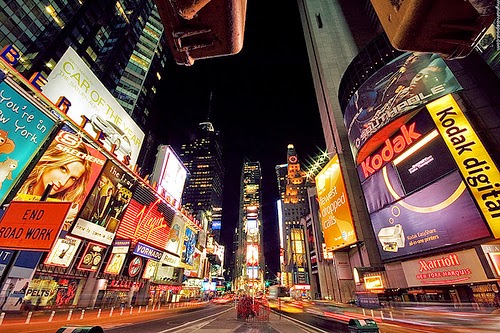I have a bit of a dilemma. Our
company specializes in sustainable lighting, yet I work in Hell's Kitchen, part of the Times Square area. According to Free Tours by Foot of NYC, "Con Ed estimated that at the peak of electrical use in the Theater District, approximately 161 Megawatts of electricity is being used at any one time. We have read that one megawatt could power one thousand U.S. homes. That's 161,000 U.S. homes."
Every morning I walk through this section of the town where lights are flashing constantly - in broad daylight. In the evening, as I leave, more lamps are added making the streets feel like a sunny day all through the night!
Yet, there's a constant push to conserve energy - insulating our homes to save heating oil, improving the mileage in our vehicles to conserve gas, and putting a few token fluorescent bulbs into our garages to save electricity. So - what about the other areas of our homes and workplaces?
Personally, I don't see a need for CFL's, especially since they contain mercury and emit more heat than LEDs. LEDs have gone through a few different incarnations in recent years and although they generate a lot of heat (yes -they do!), they have "heat sinks" which absorb and enclose it. This cuts down on your A/C electric load.
LED is available as an A Lamp - a medium/Edison base commonly used in decorative table lamps and overhead enclosed fixtures, par lamp - used for exterior floods and interior recessed fixtures, MR - used for track and recessed fixtures, tubes - to replace tubular fluorescents, and candelabra. Getting candelabras right, however, is still a challenge. We use them mostly in fixtures with exposed bulbs - like chandeliers. Since they only have an equivalent of 25-watts output, they aren't useful in every situation, and they're not very pretty since you can see the diodes (the little dotty light sources) and have a clunky heat sink. Recently developed is an incandescent-looking LED that appears to have a "filament".
All are available in a variety of wattage and color temperatures. It's important to check the Kelvin (K), which is the color temperature. The right color of light can set or break the mood, or if you're working, the right color can make your task easier. Many new LEDs are also dimmable.
If you'd like to learn more about alternative lighting - check out our Sustainable Lighting Page - chock full of existing technology used in new, more efficient ways. Very soon we will all see the world in a whole new light!



